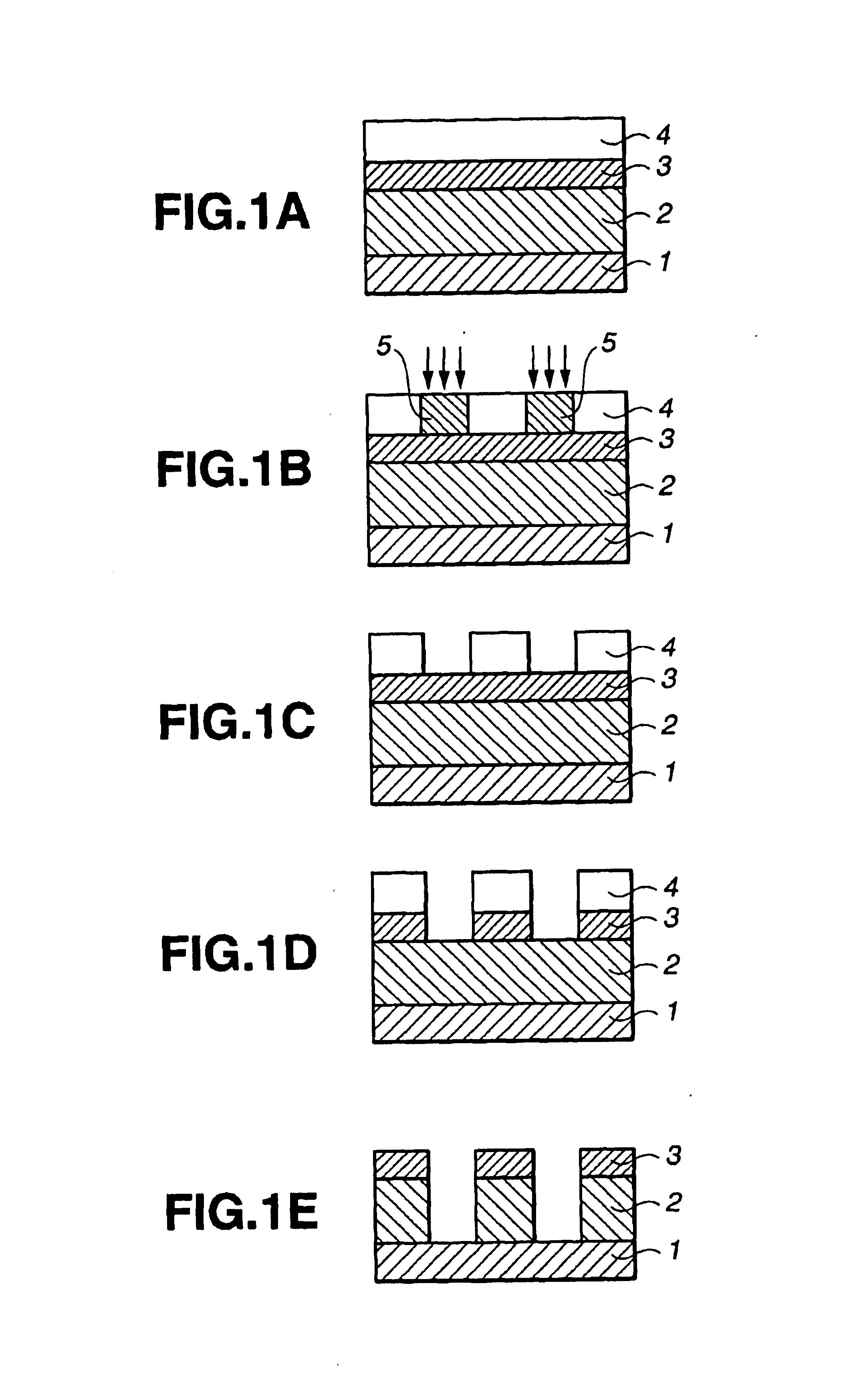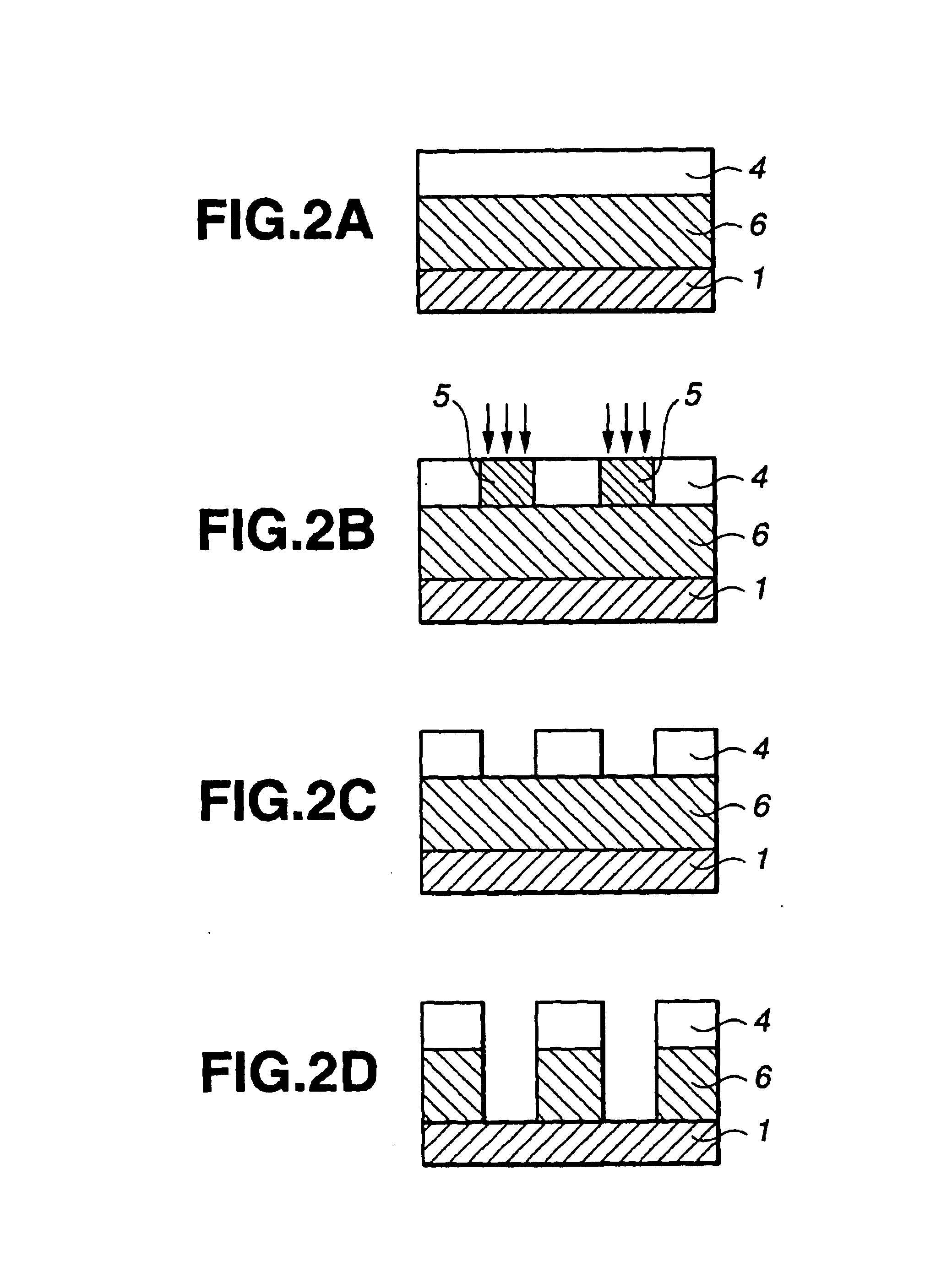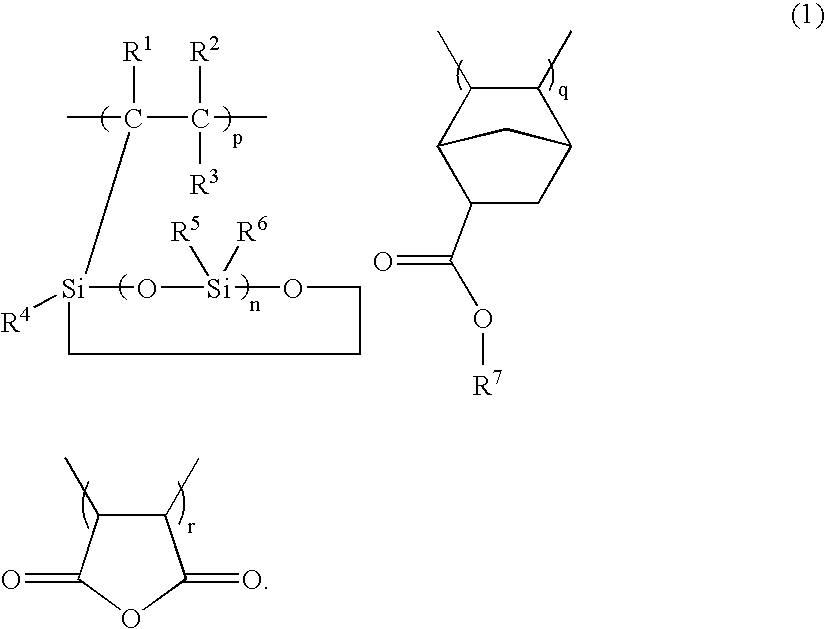Silicon-containing polymer, resist composition and patterning process
a technology of composition and patterning process, which is applied in the direction of photosensitive materials, instruments, photomechanical equipment, etc., can solve the problems of weak resistance to dry etching with oxygen plasma, inability to use as resist base resin, and silicon-containing polymer of acrylic pendant type, etc., to achieve high sensitivity, improve heat resistance, and high resolution
- Summary
- Abstract
- Description
- Claims
- Application Information
AI Technical Summary
Benefits of technology
Problems solved by technology
Method used
Image
Examples
synthesis example 1
[0298]In a 200-ml flask were admitted 27.5 g of maleic anhydride, 35.0 g of vinylheptamethylcyclotetrasiloxane, 39.5 g of monomer M-1, and 30 g of PGMEA as a solvent. The reactor was cooled to −70° C. in a nitrogen atmosphere, after which deaeration in vacuum and nitrogen flow were repeated three times. After warming to room temperature, 7.0 g of 2,2′-azobis(2,4-dimethylvaleronitrile) as a polymerization initiator was added. The reactor was heated to 55° C., at which reaction was conducted for 40 hours. The reaction solution was diluted with 20 ml of acetone and poured into 4.5 liters of methanol for precipitation. The white solid precipitate was collected by filtration and dried in vacuum at 40° C., yielding 68 g of a white polymer.
[0299]The polymer was analyzed by 13C-NMR, 1H-NMR and GPC, with the analytical results shown below.
[0300]Copolymer Compositional Ratio[0301]M-1: vinylheptamethylcyclotetrasiloxane:maleic anhydride=28.2:9.5:62.3[0302]Mw=13,200[0303]Dispersity (Mw / Mn)=1.56...
synthesis example 2
[0305]In a 200-ml flask were admitted 13.3 g of maleic anhydride, 39.7 g of vinylheptamethylcyclotetrasiloxane, 47.0 g of monomer M-2, and 30 g of PGMEA as a solvent. The reactor was cooled to −70° C. in a nitrogen atmosphere, after which deaeration in vacuum and nitrogen flow were repeated three times. After warming to room temperature, 5.6 g of 2,2′-azobis(2,4-dimethylvaleronitrile) as a polymerization initiator was added. The reactor was heated to 55° C., at which reaction was conducted for 40 hours. The reaction solution was diluted with 20 ml of acetone and poured into 4.5 liters of methanol for precipitation. The white solid precipitate was collected by filtration and dried in vacuum at 40° C., yielding 59 g of a white polymer.
[0306]The polymer was analyzed by 13C-NMR, 1H-NMR and GPC, with the analytical results shown below.
[0307]Copolymer Compositional Ratio[0308]M-2:vinylheptamethylcyclotetrasiloxane:maleic anhydride=28.2:9.5:62.3[0309]Mw=11,700[0310]Dispersity (Mw / Mn)=1.60
[...
synthesis example 3
[0312]In a 200-ml flask were admitted 13.0 g of maleic anhydride, 35.1 g of vinylheptamethylcyclotetrasiloxane, 49.5 g of monomer M-3, and 30 g of PGMEA as a solvent. The reactor was cooled to −70° C. in a nitrogen atmosphere, after which deaeration in vacuum and nitrogen flow were repeated three times. After warming to room temperature, 5.5 g of 2,2′-azobis(2,4-dimethylvaleronitrile) as a polymerization initiator was added. The reactor was heated to 55° C., at which reaction was conducted for 40 hours. The reaction solution was diluted with 20 ml of acetone and poured into 4.5 liters of methanol for precipitation. The white solid precipitate was collected by filtration and dried in vacuum at 40° C., yielding 66 g of a white polymer.
[0313]The polymer was analyzed by 13C-NMR, 1H-NMR and GPC, with the analytical results shown below.
[0314]Copolymer Compositional Ratio[0315]M-3:vinylheptamethylcyclotetrasiloxane:maleic anhydride=24.7:10.2:65.1[0316]Mw=9,700[0317]Dispersity (Mw / Mn)=1.69
[...
PUM
| Property | Measurement | Unit |
|---|---|---|
| molecular weight dispersity | aaaaa | aaaaa |
| wavelength | aaaaa | aaaaa |
| wavelength | aaaaa | aaaaa |
Abstract
Description
Claims
Application Information
 Login to View More
Login to View More - R&D
- Intellectual Property
- Life Sciences
- Materials
- Tech Scout
- Unparalleled Data Quality
- Higher Quality Content
- 60% Fewer Hallucinations
Browse by: Latest US Patents, China's latest patents, Technical Efficacy Thesaurus, Application Domain, Technology Topic, Popular Technical Reports.
© 2025 PatSnap. All rights reserved.Legal|Privacy policy|Modern Slavery Act Transparency Statement|Sitemap|About US| Contact US: help@patsnap.com



